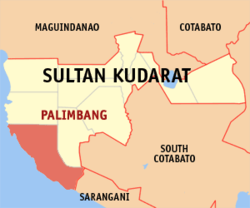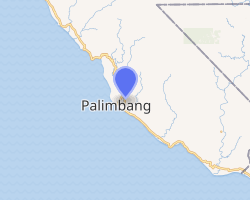Palimbang
Palimbang, officially the Municipality of Palimbang (Hiligaynon: Banwa sang Palimbang; Tagalog: Bayan ng Palimbang), is a 2nd class municipality in the province of Sultan Kudarat, Philippines. According to the 2015 census, it has a population of 90,424 people.[3]
Palimbang Pat a Inged sa Biwang Biwang | |
|---|---|
| Municipality of Palimbang | |
| Anthem: Sulong Palimbang (unofficial) | |
 Map of Sultan Kudarat with Palimbang highlighted | |
OpenStreetMap 
| |
.svg.png) Palimbang Location within the Philippines | |
| Coordinates: 6°13′N 124°12′E | |
| Country | |
| Region | Soccsksargen (Region XII) |
| Province | Sultan Kudarat |
| District | 2nd District |
| Founded | August 14, 1959 |
| Boroughs | 40 (see Barangays) |
| Government | |
| • Type | Sangguniang Bayan |
| • Mayor | Joenime B. Kapina |
| • Vice Mayor | Amil A. Pangansayan |
| • Congressman | Horacio P. Suansing, Jr. |
| • SB Members | (1) Mheit M. Talicop (2) Janifa W. Pangansayan (3) Zakiya A. Sabiwang (4) Mosaban P. Aliding (5) Sucuny A. Pendatun (6) Abubakar M. Abdullah (7) Mhark M. Siokon (8) Arbaya A. Tausing |
| • Electorate | 35,654 voters (2019) |
| Area | |
| • Total | 484.85 km2 (187.20 sq mi) |
| Population (2015 census)[3] | |
| • Total | 90,424 |
| • Density | 190/km2 (480/sq mi) |
| • Households | 18,993 |
| Economy | |
| • Income class | 2nd municipal income class |
| • Poverty incidence | 64.3% (2015)[4] |
| • Revenue (₱) | 194,262,638.89 (2016) |
| Time zone | UTC+8 (PST) |
| ZIP code | 9809 |
| PSGC | |
| IDD : area code | +63 (0)64 |
| Climate type | tropical climate |
| Native languages | Hiligaynon Maguindanao Cotabato Manobo Tagalog |
It was incorporated on August 14, 1959 through Executive Order No. 350 by President Carlos P. Garcia.
Their annual feast named Kalilang sa Biwang is celebrated every 11 November.
History
In the early days of the coming of Shariff Kabunsuan in Mindanao, Palimbang was not yet a dot on any geographical map of the island. This place was a mere abode of the primitive people whom we call not the cultural minority or highlander.
According to Tarsila, there was a tremendous change in the society due to the spread out of Islam in the coastal areas widely known as Biwang, which later paved a way toward Islamic Civilization of the inhabitants. Palimbang at that time was locally known as Pula a tree widely grown in the place. A group of fishermen from Palimbang, Indonesia was lifted by strong winds and accidentally docked at the mouth of Pula River. They were warmly welcomed by the native datus headed by Sondalo Tambuto. The hospitality shown to them reigned in their hearts and drawn the visitors to settle and intermarry with the native Muslims. A new community was developed and later named Palimbang, in honor of the fishermen's hometown, which now remained the name of the municipality.
Attempts to create Palimbang into municipality was thrice first, by the energetic leadership of Dr. Julio Sarayba in the 1940s; second, on July 24, 1953 by the seventeen (17) influential leaders of PAT-A-INGED (four communities) (1) Kraan, (2) Kanipaan, (3) Pula and (4) Maganao, namely: Dr. Julio Sarayba, Chairman; Sixto Quijano, Vice Chairman; Mr. Remegio Managad, Mr. Pedro Mamon, Mr. Pedro Bonifacio, Mr. Cresencio Geneza, Mr. Felipe Tunngala, Datu Pasay Ayao, Datu Manti Pangansayan, Mr. Lomontod Latip, Datu Talicop Lidasan, Datu Sundalo Tambuto, Haji Salik Manan, Hadji Druz Ali, Mr. Cecilio Domingo, Mr. Gorgonio Bagang, Mr. Dominador Durendez and Datu Sumana Sulog, members. Others are Datu Padasan Macut, Datu Obpon Dipatuan, Datu Pelangking Bayang and Mr. Dominador Garcia. It was a blast to the petitioners as they were regarded mentally unable to run their own government and the income of the barrios in the coastal portion was insufficient to meet the requisite of creating a new municipality. Third, by the same petitioner who collectively agreed to support candidates that will ascertain a seat of government in Palimbang in case they get elected. Fortunately, the well-supported Datu Udtog Matalam faction won. Subsequently, headed by the Provincial Governor of Cotabato Datu Udtog Matalam, the Provincial Governor of Cotabato recommended by the Members of the Board, sponsored by Congressman Salipada K. Pendatun, and supported by Datu Guiwan Mastura and Kiamba Mayor Cornelio Falgui, Palimbang was proclaimed municipality on August 14, 1959 by virtue of Executive Order No. 350, pursuant to Section 68 Revised Administrative Code, issued by His Excellency President Carlos P. Garcia.
From its creation up to the present, Palimbang was served by twelve (12) generations of municipal officials. Datu Guiwan Mastura the Deputy Governor at-large became the appointed mayor who served the municipality until the 1963 election. Datu Guiwan Mastura then became the appointed & first elected mayor of Palimbang.
Mayor Datu Guiwan Mastura lost to Mayor Datu Druz Ali, Al-Haj in the 1967 election who remained supreme until the 1986 EDSA Revolution. The Revolutionary Government under President Corazon C. Aquino appointed Mocsin Manondong, Officer-In-Charge (OIC) but he ran for Provincial Board Member. Dimalub Namil became OIC Mayor during the 1988 election.
Mayor Labualas B. Mamansual was elected in the 1988 election and was re-elected in the 1992 and 1995 elections respectively, completing the three (3) consecutive term limit. Mayor Karim “King” Daud was installed after the 1998 election. Mayor Labualas B. Mamansual was elected in the 2001 election and was re-elected in the 2004 and 2007 election, completing again the three (3) consecutive term limit. A fresh and renewed mandate, was given to Mayor Abubacar P. Maulana in the May 2010 election.
In spite of the exceptional development potentials of Palimbang, the municipality is somehow left in terms of physical development. The municipal government is exploring strategies and pouring its meager resources to meet and welcome new challenges. With the private sector at the helm of its economy, coupled with its supportive citizenry and strong political leadership committed to the full development of its human and natural resources, the municipality will certainly make its vision for development.
The municipality of Palimbang was transferred from Cotabato Province to Province of Sultan Kudarat on November 22, 1973 by presidential decree 341 of President Ferdinand E. Marcos.[5]
Malisbong Massacre
The Malisbong Masjid massacre, also called the Palimbang massacre, was the mass murder of Moros on September 24, 1974, in the coastal village of Malisbong in Palimbang, Sultan Kudarat, Mindanao where units of Gov. Siongco and the Philippine Army killed more than 1,000. Accounts compiled by the Moro Women's Center in General Santos City state that 1,500 male Moros aged 11–70 were killed inside a mosque, 3,000 women and children aged 9–60 were detained - with the women being raped and that 300 houses were razed by the government forces. The massacre occurred two years after Ferdinand Marcos declared martial law in September 1972.
The massacre started after the first four days on the feast of Ramadan when members of the Philippine Constabulary arrived and captured barangay officials along with 1,000 other Muslims and never came back. For more than a month, the military would capture murder residents in the area by batch. Testimonies show that victims were made to strip of their clothes, dig their own graves and shot.
Barangays
Palimbang is politically subdivided into 40 barangays.
- Akol
- Badiangon
- Baliango
- Baluan (Bulan)
- Bambanen
- Baranayan
- Barongis
- Batang-baglas
- Butril
- Colobe (Tagadtal)
- Datu Maguiales (Likuban)
- Domolol
- Kabuling
- Kalibuhan
- Kanipaan (converged with Sinangkangan)
- Kidayan
- Kiponget
- Kisek
- Kraan
- Kulong-kulong
- Langali
- Libua
- Ligao
- Lopoken (Lepolon)
- Lumitan
- Maganao
- Maguid
- Malatunol
- Malisbong
- Medol
- Milbuk
- Mina
- Molon
- Namat (Namat Masla & Namat Padido converged)
- Napnapon
- Poblacion
- San Roque (Former Tibulos)
- Tibuhol (East Badiangon)
- Wal
- Wasag
Climate
| Climate data for Palimbang, Sultan Kudarat | |||||||||||||
|---|---|---|---|---|---|---|---|---|---|---|---|---|---|
| Month | Jan | Feb | Mar | Apr | May | Jun | Jul | Aug | Sep | Oct | Nov | Dec | Year |
| Average high °C (°F) | 30 (86) |
30 (86) |
31 (88) |
31 (88) |
30 (86) |
29 (84) |
29 (84) |
29 (84) |
30 (86) |
29 (84) |
29 (84) |
30 (86) |
30 (86) |
| Average low °C (°F) | 24 (75) |
24 (75) |
25 (77) |
25 (77) |
25 (77) |
25 (77) |
25 (77) |
24 (75) |
25 (77) |
25 (77) |
25 (77) |
25 (77) |
25 (77) |
| Average precipitation mm (inches) | 285 (11.2) |
265 (10.4) |
303 (11.9) |
300 (11.8) |
380 (15.0) |
386 (15.2) |
332 (13.1) |
305 (12.0) |
252 (9.9) |
305 (12.0) |
355 (14.0) |
325 (12.8) |
3,793 (149.3) |
| Average rainy days | 27.0 | 24.9 | 28.1 | 28.3 | 29.5 | 28.5 | 27.7 | 26.5 | 25.1 | 28.0 | 28.7 | 28.5 | 330.8 |
| Source: Meteoblue [6] | |||||||||||||
Demographics
| Year | Pop. | ±% p.a. |
|---|---|---|
| 1948 | 4,717 | — |
| 1960 | 19,128 | +12.37% |
| 1970 | 31,696 | +5.17% |
| 1975 | 21,113 | −7.83% |
| 1980 | 24,252 | +2.81% |
| 1990 | 33,821 | +3.38% |
| 1995 | 40,646 | +3.50% |
| 2000 | 43,742 | +1.59% |
| 2007 | 78,523 | +8.40% |
| 2010 | 83,265 | +2.16% |
| 2015 | 90,424 | +1.58% |
| Source: Philippine Statistics Authority[3][7][8] | ||
Local government
List of mayors
- Datu Guiwan Mastura-
- First Municipal Mayor
- Appointed Municipal Mayor
- (1959–1963)
- Datu Cruz Ali
- Elected Municipal Mayor
- (1967–1986)
- Mocsin Manondong
- Appointed OIC Mayor
- (1986–1987)
- Dimalub Namil
- OIC-Municipal Mayor
- (1987-1988)
- Labualas B. Mamansual
- Elected Municipal Mayor
- (1988–1998)
- Karim Daud
- Elected Municipal Mayor
- (1998–2001)
- Labualas B. Mamansual
- Elected Municipal Mayor
- (2001–2010)
- Abubacar P. Maulana
- Elected Municipal Mayor
- (2010–2018)
- Haron B. Sabiwang
- Acting Municipal Mayor
- (January 2018- June 2019)
- Joenime B. Kapina
- Elected Municipal Mayor
- (2019–present)
References
- "Municipality". Quezon City, Philippines: Department of the Interior and Local Government. Retrieved 31 May 2013.
- "Province: Sultan Kudarat". PSGC Interactive. Quezon City, Philippines: Philippine Statistics Authority. Retrieved 12 November 2016.
- Census of Population (2015). "Region XII (Soccsksargen)". Total Population by Province, City, Municipality and Barangay. PSA. Retrieved 20 June 2016.
- "PSA releases the 2015 Municipal and City Level Poverty Estimates". Quezon City, Philippines. Retrieved 12 October 2019.
- "Presidential Decree No. 341, s. 1973". Official Gazette of the Republic of the Philippines. Retrieved 9 September 2017.
- "Palimbang: Average Temperatures and Rainfall". Meteoblue. Retrieved 15 May 2020.
- Census of Population and Housing (2010). "Region XII (Soccsksargen)". Total Population by Province, City, Municipality and Barangay. NSO. Retrieved 29 June 2016.
- Censuses of Population (1903–2007). "Region XII (Soccsksargen)". Table 1. Population Enumerated in Various Censuses by Province/Highly Urbanized City: 1903 to 2007. NSO.